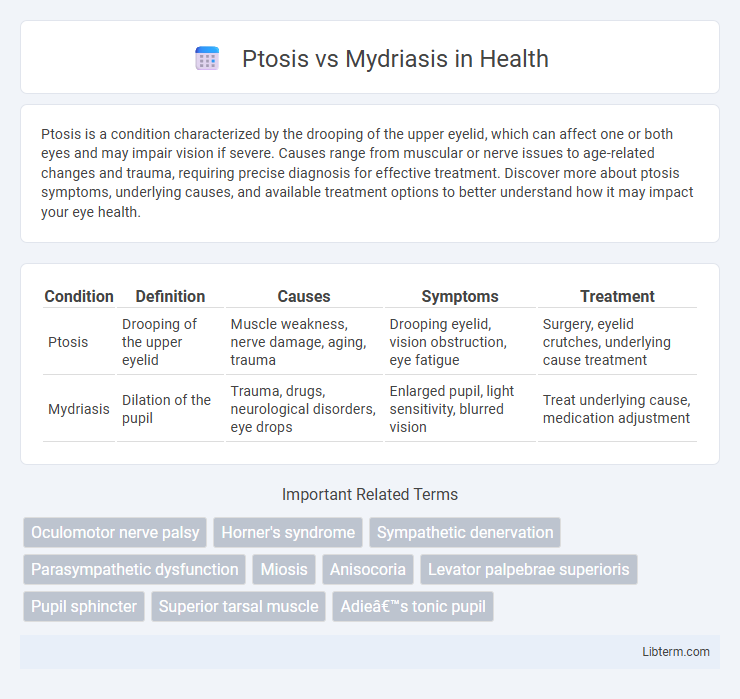Ptosis is a condition characterized by the drooping of the upper eyelid, which can affect one or both eyes and may impair vision if severe. Causes range from muscular or nerve issues to age-related changes and trauma, requiring precise diagnosis for effective treatment. Discover more about ptosis symptoms, underlying causes, and available treatment options to better understand how it may impact your eye health.
Table of Comparison
| Condition | Definition | Causes | Symptoms | Treatment |
|---|---|---|---|---|
| Ptosis | Drooping of the upper eyelid | Muscle weakness, nerve damage, aging, trauma | Drooping eyelid, vision obstruction, eye fatigue | Surgery, eyelid crutches, underlying cause treatment |
| Mydriasis | Dilation of the pupil | Trauma, drugs, neurological disorders, eye drops | Enlarged pupil, light sensitivity, blurred vision | Treat underlying cause, medication adjustment |
Understanding Ptosis and Mydriasis
Ptosis is characterized by the drooping of the upper eyelid due to muscle weakness or nerve damage, often involving the levator palpebrae superioris muscle or the oculomotor nerve. Mydriasis refers to abnormal dilation of the pupil, caused by factors such as sympathetic nervous system stimulation, medication effects, or cranial nerve III impairment. Distinguishing these conditions requires understanding their underlying pathophysiology, clinical presentation, and associated neurological signs for accurate diagnosis and treatment.
Defining Ptosis: Causes and Symptoms
Ptosis is the drooping of the upper eyelid due to weakness or paralysis of the levator muscle, often caused by nerve damage, trauma, or congenital defects. Common symptoms include partially closed eyelids, impaired vision, and eye fatigue. Conditions such as Horner's syndrome, myasthenia gravis, and third cranial nerve palsy are frequent underlying causes of ptosis.
What is Mydriasis? Overview and Key Features
Mydriasis is the medical term for the abnormal dilation of the pupil, often caused by trauma, drug use, or neurological disorders affecting the iris muscles or autonomic nervous system. Key features include an enlarged pupil unresponsive to light changes, blurred vision, and sensitivity to bright lights. This condition contrasts with ptosis, which involves drooping of the upper eyelid rather than pupil size abnormalities.
Comparing Ptosis and Mydriasis: Key Differences
Ptosis refers to the drooping of the upper eyelid due to muscle weakness or nerve damage, while mydriasis is characterized by abnormal dilation of the pupil often caused by sympathetic overactivity or parasympathetic inhibition. Ptosis affects eyelid function and appearance by restricting the field of vision, whereas mydriasis primarily impacts pupil size and light regulation, leading to sensitivity or blurred vision. Understanding these distinct physiological mechanisms is crucial for diagnosing underlying neurological or muscular disorders.
Underlying Medical Conditions Linked to Ptosis
Ptosis, characterized by drooping of the upper eyelid, is often linked to underlying neurological or muscular conditions such as Horner's syndrome, myasthenia gravis, or third cranial nerve palsy. In contrast, mydriasis, defined by abnormal pupil dilation, is commonly associated with trauma, pharmacologic agents, or intracranial pathology but generally does not cause eyelid drooping. Understanding these distinct underlying medical conditions is critical for accurate diagnosis and effective management of each disorder.
Common Causes of Mydriasis
Mydriasis, characterized by the dilation of the pupil, commonly results from medications such as anticholinergics or sympathomimetics, neurological conditions like third cranial nerve palsy, or acute eye trauma. Unlike ptosis, which involves the drooping of the upper eyelid due to muscle or nerve dysfunction, mydriasis specifically affects pupil size and reactivity. Identifying causes such as Adie's tonic pupil or pharmacological agents is critical for accurate diagnosis and treatment.
Diagnosis: How Ptosis and Mydriasis are Identified
Ptosis is diagnosed by assessing the degree of eyelid drooping, measuring the margin reflex distance, and evaluating muscle function through the eyelid levator test. Mydriasis is identified by observing pupil dilation, performing a pupillary light reflex test to check the response to light, and using pharmacological agents to determine the underlying cause. Clinical examination combined with neuroimaging or blood tests may be necessary to differentiate between neurological or systemic origins of both conditions.
Treatment Options for Ptosis
Treatment options for ptosis primarily depend on the severity and underlying cause; mild cases may improve with eyelid exercises or the use of ptosis crutches attached to glasses. Surgical procedures, such as levator resection or frontalis sling, are commonly performed to tighten or elevate the eyelid muscles in more severe or congenital cases. Non-surgical approaches, including botulinum toxin injections, may provide temporary relief in acquired ptosis, but surgery remains the definitive treatment to restore eyelid function and appearance.
Management and Treatment of Mydriasis
Management of mydriasis primarily involves identifying and treating the underlying cause, such as nerve damage, drug effects, or neurological disorders. Pharmacological interventions may include the use of pilocarpine eye drops to constrict the pupil and alleviate symptoms, while severe cases might require addressing systemic conditions through corticosteroids or other specific therapies. Regular monitoring by an ophthalmologist ensures prevention of complications like photophobia or vision impairment.
When to Seek Medical Attention for Ptosis or Mydriasis
Seek medical attention immediately for sudden onset of ptosis or mydriasis, as these symptoms may indicate serious neurological conditions such as Horner's syndrome, third cranial nerve palsy, or brain aneurysm. Persistent or progressive eyelid drooping (ptosis) or abnormal pupil dilation (mydriasis) accompanied by vision changes, eye pain, or headache requires urgent evaluation by an ophthalmologist or neurologist. Early diagnosis and treatment are crucial to prevent vision loss and address underlying systemic diseases.
Ptosis Infographic

 libterm.com
libterm.com